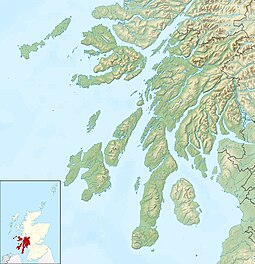Inchmarnock
| Gaelic name | Innis Mhearnaig |
|---|---|
| Meaning of name | Island of St. Marnock |
| Location | |
|
Inchmarnock shown in Argyll and Bute
|
|
| OS grid reference | NS020598 |
| Coordinates | 55°47′N 5°10′W / 55.79°N 05.16°W |
| Physical geography | |
| Island group | Islands of the Clyde |
| Area | 266 hectares (1.03 sq mi) |
| Area rank | 93 |
| Highest elevation | 60 metres (197 ft) |
| Administration | |
| Sovereign state | United Kingdom |
| Country | Scotland |
| Council area | Argyll and Bute |
| Demographics | |
| Population | 0 |
| References | |
Inchmarnock (Scottish Gaelic: Innis Mheàrnaig) is an island at the northern end of the Sound of Bute in the Firth of Clyde, on the west coast of Scotland.
Inchmarnock lies to the west of the Isle of Bute at the northern end of the Sound of Bute. It is around 3.5 kilometres (2.2 mi) long and rises to a height of 60 metres (197 ft). The island consists mainly of a single ridge running north to south. It is partially wooded and has sea caves at the north and the south and two tiny lochans inland. The island belongs to the traditional county of Bute and the modern unitary authority of Argyll and Bute. It is not to be confused with Inchmarnock in Aberdeenshire. Divided into three farms, Southpark, Midpark and Northpark, only the latter is currently inhabited. A short reef of drying rocks, Tràigh na h-Uil, skirts the island's west coast.
The island gives its name to Inchmarnock Water, the body of water that lies between the island's western shore and the Kintyre peninsula. Inchmarnock Water connects the Sound of Bute and the Kilbrannan Sound in the south to Loch Fyne and the Kyles of Bute in the north.
At the northern end of the island a Bronze Age cist contains the remains of a female skeleton, the Queen of the Inch. The remains were removed for carbon dating and are now displayed behind a pane of glass in their original position.
The island's name is an anglicisation of the Gaelic Innis Mheàrnaig meaning Island of Saint Marnock. Marnock, (Old Irish M'Ernóc, 'My [i.e. 'Saint'] Little Ernán) was a holy man who lived on the island in the 7th century and established a monastery. Alternatively, the name may simply be a dedication to Ernán and reflect the patron saint the monks on the island followed. He has also lent his name to a number of other locations:
...
Wikipedia

